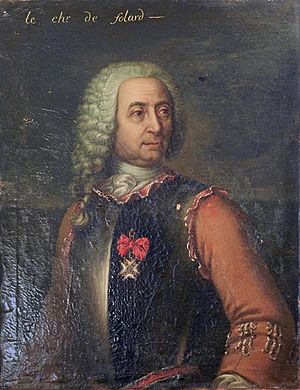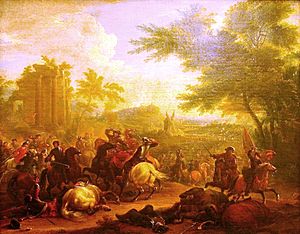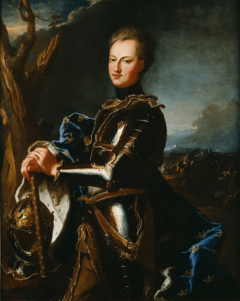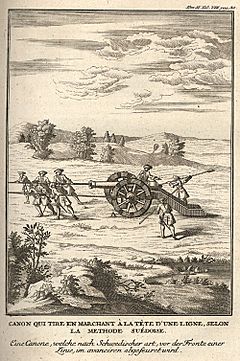Chevalier de Folard facts for kids
Quick facts for kids
Jean Charles, Chevalier de Folard
|
|
|---|---|

Chevalier de Folard in old age; 18th century
|
|
| Born | 13 February 1669 Avignon, France |
| Died | 23 March 1752 (aged 83) Avignon, France |
| Allegiance | |
| Years of service | 1687 – 1719 |
| Rank | Colonel |
| Battles/wars | Nine Years War War of the Spanish Succession Cassano (WIA); Siege of Modena; Malplaquet (WIA) Great Northern War War of the Quadruple Alliance Siege of San Sebastián (1719) |
| Awards | Order of Saint Louis |
Jean Charles, Chevalier de Folard (born February 13, 1669 – died March 23, 1752) was a French soldier and military thinker. He is famous for suggesting that armies should use infantry columns instead of long, thin lines. Even though many people didn't agree with his ideas at the time, his thoughts on military strategy stayed important for a long time.
| Top - 0-9 A B C D E F G H I J K L M N O P Q R S T U V W X Y Z |
Who Was Jean Charles de Folard?
Jean Charles de Folard was born in Avignon, France. His family had moved there from England a long time ago. His father was a law professor. Jean Charles was one of seven children.
Folard's Military Journey
Starting in the Army
Folard studied with the Jesuits, but he really wanted to be a soldier. When he was 16, he ran away to join the French Royal Army. He was inspired by reading Caesar's "Commentaries", which are stories about ancient wars.
In 1687, he officially joined the army as an Officer cadet. He became a Second lieutenant in 1688 when the Nine Years War began. His unit mostly stayed in garrisons (military bases). By the time the war ended in 1697, he was a lieutenant.
Fighting in the War of the Spanish Succession

The War of the Spanish Succession started in 1701. Folard's regiment went to Naples in 1702. He spent three years there, coming up with new tactical ideas. These ideas caught the attention of the duc de Vendôme, who was a top French commander.
In 1703, Savoy joined the side against France. Folard then served in Lombardy. He was good at engineering and became a technical advisor.
In August 1705, he was badly wounded in the stomach at the Battle of Cassano. For his bravery, he received the Cross of St. Louis award. While he was recovering, Folard started to develop his famous ideas about using infantry columns in battle.
He recovered and returned to duty in 1706. He was part of the French forces in Modena. After a long siege, Modena surrendered in 1707. Folard then went to Flanders and served under Vendôme again.
In 1709, he was wounded again at the Malplaquet. Even though the war was slowing down, Folard kept sending his superiors new ideas. In 1711, he became military Governor of Bourbourg. After the war ended in 1713, he lost this job but kept half his pay.
Later Military Adventures

In 1714, Folard joined French officers helping the Knights Hospitallers in Malta. He later went to Sweden in 1716 to serve Charles XII of Sweden. Folard thought Charles XII was the best general of his time.
While in Stockholm, Folard wrote down his tactical ideas. He based them on the writings of the Greek historian Polybius. In 1717, he left Sweden due to illness. On his way home, his ship sank, and he lost all his papers.
During the War of the Quadruple Alliance, Folard served at the Siege of San Sebastián in 1719. He was finally promoted to Colonel. However, he often argued with his commanders. He even wrote to the Minister of War, criticizing his superior's cautious tactics. After this, his active military career ended.
Life After the Army
Folard spent the next ten years writing his commentaries on Polybius. These books were published in 1724 and 1729. In them, he looked at ancient battles to find general rules for military strategy and leadership.
Many of his ideas were not popular at the time. After Folard died in 1752, Frederick the Great (a famous king and general) created a handbook based on Folard's work. This handbook focused on Folard's ideas about attacking with bayonets. Frederick wanted his officers to be very aggressive.
Folard died on March 23, 1752, in Avignon. Today, some public buildings and streets in Avignon are named after him.
Folard's Military Ideas
After the War of the Spanish Succession, the French army was no longer seen as the best in Europe. This led to many discussions about new tactics. Folard's work was a big part of these talks.
His most famous idea was using deep infantry columns instead of thin lines. He believed lines were too weak for attacking and not strong enough for defense. He studied ancient Greek battles and the use of the Phalanx (a deep formation of soldiers). He thought a deep mass of troops could break enemy lines and provide strong defense.
Folard also suggested a "mixed order of battle." This meant having infantry, cavalry, and light cannons all together. They would support each other in battle.
However, many people pointed out problems with his ideas:
- Columns were hard to control once they started moving, especially if they were pushed back. Folard argued his attacks would never fail.
- Columns could be easily attacked from the sides.
- They had a low rate of fire. Folard mistakenly thought modern firearms weren't powerful enough to win battles alone. But by the 1730s, weapons had improved a lot.
- His mixed order meant cavalry had to move slowly with the infantry, which made them less effective for quick attacks.
Even though his specific system wasn't widely adopted, Folard's ideas were still very influential. They became important again after France's defeat in the Seven Years' War (1756-1763). His belief that bayonet charges were perfect for the "French offensive spirit" even influenced tactics before World War I. These ideas led to Plan XVII, a French plan that caused huge losses when faced with machine guns and modern artillery.
Images for kids






